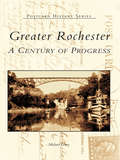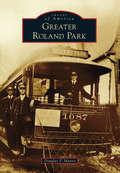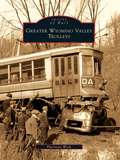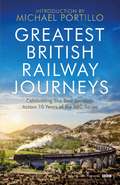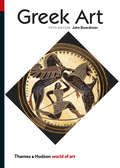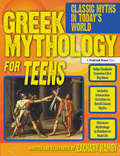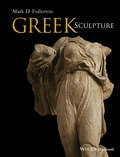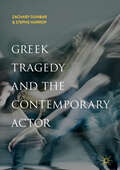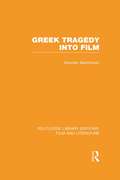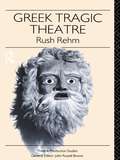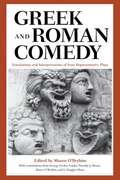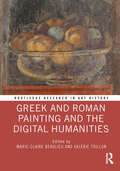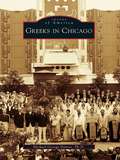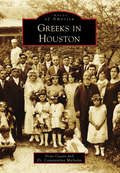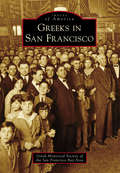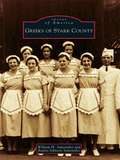- Table View
- List View
Greater Hartford Firefighting (Images of America)
by The Connecticut Fire MuseumThe Hartford area has a rich history of firefighting, beginning with the bucket brigades of early colonial history. As devastating blazes razed many key buildings and entire neighborhoods, these small teams developed into large volunteer groups. The city finally realized that paid fire departments were needed, and the modern firefighting world bloomed with technological advances in equipment and procedures. The evolution of these brave firefighting groups is richly chronicled in Greater Hartford Firefighting.
Greater Rochester: A Century of Progress (Postcard History)
by Michael LeavyGreater Rochester: A Century of Progress presents the glory years of Rochester in more than two hundred stunning images, beautifully crafted by photographers, engravers, lithographers, and illustrators. It reveals how pioneers built a wilderness town around a river and waterfalls, and how it grew into a truly unique American city. It recognizes the great contributions of courageous individuals who advanced their issues and improved their communities, among them Frederick Douglass, Susan B. Anthony, and George Eastman, and the marvels of the day-the hotels, bridges, canals, railroads, and other accomplishments.
Greater Roland Park
by Douglas P. MunroDeveloper Edward Bouton revolutionized American life with the creation of Roland Park, one of the country's first "streetcar suburbs," located in Baltimore, Maryland. Unlike many late-19th-century suburbs, Roland Park is well preserved, and many would consider it a late-Victorian version of Colonial Williamsburg. In the 20th century, Bouton also created Roland Park's sister developments: Guilford, Homeland, and Original Northwood. The latter two were developed after the heyday of the streetcar; in contrast, Roland Park without streetcars would have been unthinkable. Even now, trolley memories abound in the form of surviving old trackage and waiting shelters. Greater Roland Park explores the development of the suburb and its neighbors: Embla Park, Evergreen, Keswick, Lake Falls, Lake Roland, New North Roland Park, The Orchards, Poplar Hill, and Tuxedo Park.
Greater Wyoming Valley Trolleys
by Harrison WickThe Wyoming Valley is nestled among the Endless Mountains in Luzerne County with the scenic Susquehanna River meandering through it. Best known for its rich deposits of anthracite coal, the Wyoming Valley was first colonized by Connecticut settlers in 1769. Electric trolleys served many urban centers in Pennsylvania. Trolley service in the Wyoming Valley started in 1888 and lasted for more than 60 years. Trolley lines went through the boroughs and townships of Ashley, Courtdale, Edwardsville, Forty Fort, Hanover, Kingston, Larksville, Miners Mills, Nanticoke, Parsons, Pittston, Plains, Plymouth, Sugar Notch, West Pittston, West Wyoming, Wilkes-Barre, and Wyoming. Greater Wyoming Valley Trolleys features rare photographs dating from the 1890s to 1950 documenting the trolley system and the communities of the Wyoming Valley.
Greatest British Railway Journeys: Celebrating the greatest journeys from the BBC's beloved railway travel series
by Michael PortilloIt is now over a decade since the much-loved Great British Railway Journeys series set off on its incredible run discovering the cultural, social and engineering landscape of the United Kingdom through the prism of George Bradshaw's Handbook to rail travel. Veteran politician and ex cabinet minister Michael Portillo has since presented eleven seasons of this ever-popular show on BBC Two, covering every part of the existing train network in Britain, as well as others that were closed as a result of the Beeching Report in 1963. Across a decade of these journeys, Portillo has celebrated how every corner of England, Scotland, Wales and Northern Ireland was opened up by the railway line as a result of the Industrial Revolution, thus giving fans a unique insight into our shared past of train travel since the Victorian era. With the anniversary, this new collection will celebrate Michael's top fifty journeys from the hundreds he has covered, adding more insight and analysis to some of the greatest railway lines, stations, bridges, viaducts and tunnels the Victorians built to create the world we now live in. From Paddington Station to the Clifton Suspension Bridge; the Southend Pier line to the milk wagons departing from Blake Hall Station. An unrivalled narrative to be treasured. Greatest British Railway Journeys is both a celebratory and charming ride through our country's beloved history - all from the unique position of a train seat.
Greek Art (Fifth) (World of Art)
by John Boardman“One of the very best short histories of Greek Art.” — The Financial Times John Boardman, one of the best known and acknowledged scholars of the classical Greek world, has updated his definitive survey of its arts, the most influential and widely known historic artistic tradition of the Old World. In the twenty years since the last edition was released, valuable evidence has come to light which has dramatically enhanced our understanding of the arts of ancient Greece and their influence. It is now known that Greek artists completed their stone sculptures with realistic color, as well as working with a wealth of other materials. This proves that the romantic notion of an age of classic, pure white marble is a Renaissance construction which has persisted to the present day. The work of individual artists, as well as schools of artists, can be identified, creating a clearer picture than ever before of how art and artistic traditions traveled throughout the Greek world and beyond it. Boardman encourages the reader to consider the masterpieces that have been preserved in their original context. He weaves into his discussion of the arts insights into the society that produced them. Illustrated in full color throughout for the first time, this fifth edition demonstrates yet more vividly the artistic aims and achievements of ancient Greece.
Greek Art And Archaeology
by Richard T. NeerThis is the text that sets a new standard in its field with striking visuals, fascinating reconstructions, accessible prose, and coverage of the wider Greek world. The Second Edition extends student understanding of Greek art in history through richer archaeological context and expanded coverage of both the earliest Bronze Age and latest Hellenistic periods.
Greek Culture in the Roman World: Greek Myths in Roman Art and Culture
by Zahra NewbyImages of episodes from Greek mythology are widespread in Roman art, appearing in sculptural groups, mosaics, paintings and reliefs. They attest to Rome's enduring fascination with Greek culture, and its desire to absorb and reframe that culture for new ends. This book provides a comprehensive account of the meanings of Greek myth across the spectrum of Roman art, including public, domestic and funerary contexts. It argues that myths, in addition to functioning as signifiers of a patron's education or paideia, played an important role as rhetorical and didactic exempla. The changing use of mythological imagery in domestic and funerary art in particular reveals an important shift in Roman values and senses of identity across the period of the first two centuries AD, and in the ways that Greek culture was turned to serve Roman values.
Greek Mythology for Teens: Classic Myths in Today's World (Grades 7-12)
by Zachary HambyGreek Mythology for Teens takes classical mythology to a new level by relating ancient stories to the culture, history, art, and literature of today. The book uses the innovative approach of reader's theater to teach mythology to teens, asking them to act out the stories and become engaged in a common learning experience. By looking at topics instrumental to both mythology and modern culture, teens are encouraged to question topics such as heroism, foolishness, love, and more. Each chapter builds on a particular theme found in the central myth and includes activities, discussion questions, and exercises that connect the myth to the modern world and everyday life. Visually-appealing sidebars also give background on Greek and Roman mythology and culture. Greek Mythology for Teens takes the classic myths taught in school and turns them into an engaging, interesting, and modern way of looking at old material.Grades 7-12
Greek Sculpture
by Mark D. FullertonGreek Sculpture presents a chronological overview of the plastic and glyptic art forms in the ancient Greek world from the emergence of life-sized marble statuary at the end of the seventh century BC to the appropriation of Greek sculptural traditions by Rome in the first two centuries AD. Compares the evolution of Greek sculpture over the centuries to works of contemporaneous Mediterranean civilizations Emphasizes looking closely at the stylistic features of Greek sculpture, illustrating these observations where possible with original works rather than copies Places the remarkable progress of stylistic changes that took place in Greek sculpture within a broader social and historical context Facilitates an understanding of why Greek monuments look the way they do and what ideas they were capable of expressing Focuses on the most recent interpretations of Greek sculptural works while considering the fragile and fragmentary evidence uncovered
Greek Sculpture
by Nigel SpiveyAncient Greek sculpture seems to have a timeless quality - provoking reactions that may range from awe to alienation. Yet it was a particular product of its age: and to know how and why it was once created is to embark upon an understanding of its 'Classic' status. In this richly-illustrated and carefully-written survey, encompassing works from c. 700 BC to the end of antiquity, Nigel Spivey expounds not only the social function of Greek sculpture but also its aesthetic and technical achievement. Fresh approaches are reconciled with traditional modes of study as the connoisseurship of this art is sympathetically unravelled, while source material and historical narratives are woven into detailed explanations, putting the art into its proper context. Greek Sculpture is the ideal textbook for students of classics, classical civilization, art history and archaeology - and an accessible account for all interested readers.
Greek Theatre Performance
by David WilesIn this book, David Wiles introduces ancient Greek theater to students and enthusiasts interested in knowing how the plays were performed. Theater was a ceremony bound up with fundamental activities in ancient Athenian life and Wiles explores those elements that created the theater of the time. Actors rather than writers are the book's main concern and Wiles examines how the actor used the resources of story-telling, dance, mask, song and visual action to create a large-scale event that would shape the life of the citizen community.
Greek Tragedy and the Contemporary Actor
by Zachary Dunbar Stephe HarropThis book offers a provocative and groundbreaking re-appraisal of the demands of acting ancient tragedy, informed by cutting-edge scholarship in the fields of actor training, theatre history, and classical reception. Its interdisciplinary reach means that it is uniquely positioned to identify, interrogate, and de-mystify the clichés which cluster around Greek tragedy, giving acting students, teachers, and theatre-makers the chance to access a vital range of current debates, and modelling ways in which an enhanced understanding of this material can serve as the stimulus for new experiments in the studio or rehearsal room. Two theoretical chapters contend that Aristotelian readings of tragedy, especially when combined with elements of Stanislavski’s (early) actor-training practice, can actually prevent actors from interacting productively with ancient plays and practices. The four chapters which follow (Acting Sound, Acting Myth, Acting Space, and Acting Chorus) examine specific challenges in detail, combining historical summaries with a survey of key modern practitioners, and a sequence of practical exercises.
Greek Tragedy into Film (Routledge Library Editions: Film and Literature)
by Kenneth MacKinnonIf Greek tragedy is sometimes regarded as a form long dead and buried, both theatre producers and film directors seem slow to accept its interment. Originally published in 1986, this book reflects the renewed interest in questions of staging the Greek plays, to give a comprehensive account and critical analysis of all the important versions of Greek tragedy made on film. From the 1927 footage of the re-enactment of Aeschylus’ Prometheus in Chains at the Delphi Festival organised by Angelos Sikelianos to Pasolini’s Notes for an African Oresteia, the study encompasses the version of Oedipus by Tyrone Guthrie, Tzavellas’s Antigone (with Irene Papas), Michael Cacoyannis’s series which included Electra, The Trojan Women, and Iphigeneia, Pasolini’s Oedipus and Medea (with Maria Callas), Miklos Jancso’s Elektreia, Dassim’s Phaedra and others. Many interesting questions are raised by the transference of a highly stylised form such as Greek tragedy to what is often claimed to be the ‘realistic’ medium of film. What becomes clear is that the heroic myths retain with ease the power to move the audiences in very different milieux through often strikingly different means. The book may be read as an adjunct to viewing of the films, but enough synopsis is given to make its arguments accessible to those familiar only with the classical texts, or with neither version.
Greek Tragic Theatre (Understanding the Ancient World)
by Rush RehmEmphasizing the political nature of Greek tragedy, as theatre of, by and for the polis, Rush Rehm characterizes Athens as a performance culture; one in which the theatre stood alongside other public forums as a place to confront matters of import. In treating the various social, religious and practical aspects of tragic production, he shows how these elements promoted a vision of the theatre as integral to the life of the city - a theatre focussed on the audience.
Greek Vase-painting and the Origins of Visual Humour
by Alexandre G. MitchellA comprehensive study of visual humour in ancient Greece, with special emphasis on works created in Athens and Boeotia. Alexandre Mitchell brings an interdisciplinary approach to this topic, combining theories and methods of art history, archaeology, and classics with the anthropology of humour, and thereby establishing new ways of looking at art and visual humour in particular. Understanding what visual humour was to the ancients and how it functioned as a tool of social cohesion is only one facet of this study. Mitchell also focuses on the social truths that his study of humour unveils: democracy and freedom of expression, politics and religion, Greek vases and trends in fashion, market-driven production, proper and improper behaviour, popular versus elite culture, carnival in situ, and the place of women, foreigners, workers, and labourers within the Greek city.
Greek and Roman Aesthetics
by Oleg V. Bychkov Anne SheppardThis anthology of philosophical texts by Greek and Roman authors brings together works from the late fifth century BC to the sixth century AD that comment on major aesthetic issues such as the perception of beauty and harmony in music and the visual arts, structure and style in literature, and aesthetic judgement. It includes important texts by Plato and Aristotle on the status and the role of the arts in society and in education, and Longinus' reflections on the sublime in literature, in addition to less well-known writings by Philodemus, Cicero, Seneca, Plotinus, Augustine and Proclus. Most of the texts have been newly translated for this volume, and some are available in English for the first time. A detailed introduction traces the development of classical aesthetics from its roots in Platonism and Aristotelianism to its ultimate form in late Antiquity.
Greek and Roman Architecture in Classic Drawings
by Hector D’espouyPerhaps the finest record of classical architectural detail ever made. Executed in the demanding technique of India ink and water color rendering, the illustrations include the Parthenon, Roman temples, Pantheon, Colosseum, many others. Unparalleled three-dimensionality and effects of scale. Enhanced with Introductory Notes by John Blatteau and Christiane Sears. Notes. Preface. 127 plates.
Greek and Roman Comedy: Translations and Interpretations of Four Representative Plays
by Shawn O'BryhimMuch of what we know of Greco-Roman comedy comes from the surviving works of just four playwrights—the Greeks Aristophanes and Menander and the Romans Plautus and Terence. <P><P>To introduce these authors and their work to students and general readers, this book offers a new, accessible translation of a representative play by each playwright, accompanied by a general introduction to the author's life and times, a scholarly article on a prominent theme in the play, and a bibliography of selected readings about the play and playwright.<P>This range of material, rare in a single volume, provides several reading and teaching options, from the study of a single author to an overview of the entire Classical comedic tradition. The plays have been translated for readability and fidelity to the original text by established Classics scholars. Douglas Olson provides the translation and commentary for Aristophanes' Acharnians, Shawn O'Bryhim for Menander's Dyskolos, George Fredric Franco for Plautus' Casina, and Timothy J. Moore for Terence's Phormio.
Greek and Roman Painting and the Digital Humanities (Routledge Research in Art History)
by Marie-Claire Beaulieu Valérie ToillonThis volume is a groundbreaking discussion of the role of digital media in research on ancient painting, and a deep reflection on the effectiveness of digital media in opening the field to new audiences. The study of classical art always oscillates between archaeology and classics, between the study of ancient texts and archaeological material. For this reason, it is often difficult to collect all the data, to have access to both types of information on an equal basis. The increasing development of digital collections and databases dedicated to both archaeological material and ancient texts is a direct response to this problem. The book’s central theme is the role of the digital humanities, especially digital collection,s such as the Digital Milliet, in the study of ancient Greek and Roman painting. Part 1 focuses on the transition between the original print version of the Recueil Milliet and its digital incarnation. Part 2 addresses the application of digital tools to the analysis of ancient art. Part 3 focuses on ancient wall painting. The book will be of interest to scholars working in art history, classics, archaeology, and digital humanities.
Greeks in Chicago
by Ph.D., Michael DavrosGreeks arrived in America with the expectation that freedom would permit their families to thrive and be successful. With hard work, belief in the Orthodox faith, and commitment to education, Greeks ascended in Chicago, and America, to positions of responsibility and success. Today Greek Americans are among the wealthiest and most successful of immigrant groups. Greeks recognized a historical imperative that they meet the challenges and aspirations of a classical Hellenic heritage. Greeks in Chicago celebrates the rich history of the Greek community through copious pictorial documentation.
Greeks in Houston
by Irene Cassis Constantina MichalosThis history of the Greeks in Houston is really the story of individuals who worked diligently to forge new lives for themselves even as they maintained their Greek identity and their Orthodox faith. The efforts of many of the founders are immortalized in the buildings that constitute the Annunciation Greek Orthodox Cathedral complex. Their names remind us of their hard work and commitment to establishing their koinonia (communion) in Houston. There are many other names that have gone unremarked over the decades but to whom we owe just as much for their tenacity and dedication. And there are the new generations who inherited this legacy and keep it vibrant through the stewardship of their faith and culture.
Greeks in San Francisco (Images of America)
by Greek Historical Society of the San Francisco BayThe history of San Francisco's Greek community is linked to the history of San Francisco. The first Greeks to arrive were sailors, miners, and laborers. By the 1880s, they had formed benevolent, civic, and fraternal organizations. In 1904, the first Greek Orthodox Church west of Chicago was established, and Third Street became the heart of the Greek community. The 1906 earthquake and fire destroyed much of their new community, but undaunted, the Greeks of San Francisco rebuilt their lives to become business leaders and politicians, contributing their entrepreneurial and philanthropic spirit to the city's rich heritage.
Greeks in Tarpon Springs (Images of America)
by Tina BucuvalasBeginning in 1905, large numbers of Greeks from the Dodecanese and Saronic Gulf islands settled in Tarpon Springs to work in the sponge business. They significantly expanded the industry and changed Tarpon Springs forever. Greektown flourished with residences, stores, churches, restaurants, and recreational facilities stretching from the sponge docks to downtown. Sponge fishing and related activities served as the economic base for the community. By 1913, as many as half of Tarpon Springs residents were reputedly Greek, and many businesses displayed both Greek and American flags. Today, Tarpon Springs' Greek community preserves a strong ethnic and maritime heritage. While some major US cities have a larger Greek population, no other has a greater percentage with Greek heritage than Tarpon Springs.
Greeks of Stark County
by Regine Johnson Samonides William H. SamonidesBy the early 20th century, Stark County was one of the fastest-growing regions in the nation. The home of martyred president William McKinley had become a major industrial center, with alloy steel as the engine of growth for the booming local economy. To fill the ever-increasing demand for labor, waves of immigrants from Greece and Asia Minor settled in Canton and Massillon. Some sought economic opportunity; others were fleeing the Pontian Black Sea coast, where ethnic cleansing of Greeks accompanied the creation of the Turkish state. For the immigrant earning less than $3 a day, building a church meant making a commitment to a new life. In Canton, St. Haralambos Greek Orthodox Church was founded in 1913 and Holy Trinity Greek Orthodox Church in 1917. In Massillon, St. George Greek Orthodox Church was established in 1931. Churches and mutual aid organizations provided cohesiveness to the dynamic, often fractious, Greek community, which survived world wars, economic depression, and social discrimination and continues to flourish today.

